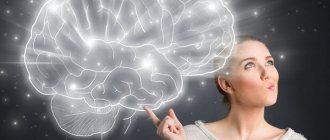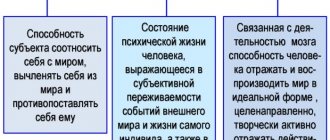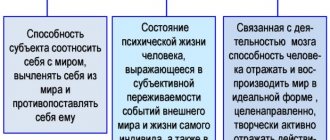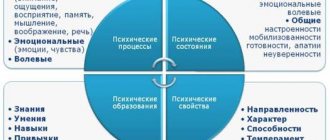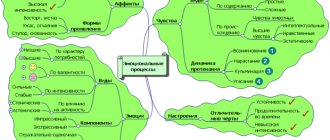Content
- Mental processes
- Mental properties
- Mental conditions
This section is studied from the 1st year of the Faculty of Psychology, since the knowledge acquired in this subject is the basis for studying further material in all sections of psychology. The results of research in the field of general psychology are also the basis for the development of all branches and sections of psychological science.
General psychology studies cognitive processes, patterns and properties of the psyche, manifestations of various mental phenomena, various theories and concepts of outstanding psychologists, and forms concepts and terms.
The subject of general psychology is mental phenomena, i.e. mental processes, mental properties, mental states.
Mental phenomena are a general psychological category that includes various manifestations of the psyche that are closely interrelated and interdependent.
Activities and mental processes
Types of human activities
The main types of human activity correspond to general needs, or more precisely, to the types of social human activity into which everyone is inevitably involved in the process of their individual development. Communication, games, learning and work should be considered as the main activities of people [10].
Communication is the first type of activity that arises in the process of individual human development. It is followed by play, learning, and work.
These types of activities are developmental in nature.
Communication can be direct and indirect, verbal and non-verbal; with indirect communication there are no direct contacts between people.
A game is a type of activity, the result of which is the acquisition of some practical skills. There are several types of games: individual and group, subject, plot, role-playing, games with given rules.
Gaming behavior and gaming relationships have little effect on real relationships between people, especially among adults.
Under the influence of the integration of social structures, economic growth, the development of cooperation, and the division of labor, activities are socialized.
In the process of development of activity, its internal transformation occurs:
– its object and means of satisfying the needs associated with it become new cultural objects;
– activities accelerate and improve results, facilitated by recording results and new technologies;
– in the process of business development, automation of individual operations occurs. They turn into skills and abilities;
– as a result of the development of activities, new types of activities can be distinguished, isolated and independently developed.
Mental processes - perception, attention, memory, thinking - are the most important components of any human activity.
But it turns out that mental processes do not just participate in activity, they develop in it and themselves represent special types of activity.
Thus, in the process of practical activity, images are formed (objects of perception, depth, directions, speed, shapes).
Imagination
– the texture of imagination is a reflection of the experience of practical activity.
Memory
– memorization and reproduction; It is known that conscious reproduction of the activity during which the material was memorized makes it easier to recall.
Thinking
– in a number of its forms is identical to practical activity.
In developed forms of thinking (figurative and logical), the activity element appears in the form of internal, mental actions and operations.
Speech is also a special kind of activity. It has been experimentally proven that internal, i.e. mental, processes (higher mental functions) are activities in origin and structure.
Higher activity, as a result of special transformations aimed at reducing and automating individual links, their transformation into skills, gradually turns into internal, mental.
When a person solves problems, his articulatory apparatus almost always works. Speech activity without movements of the larynx and facial muscles is impossible.
Consequently, any activity is a combination of internal and external, mental and behavioral actions and operations.
Automated, consciously, semi-consciously controlled components of activity are called skills, abilities and habits, respectively.
Skill
is an element of activity that allows you to do something with high quality. Skills include automatically performed elements of an activity.
Skills
– automated, instinct-like components of skills, implemented at the level of unconscious control. Skills are part of the structure of actions and various activities; they usually interact with each other, forming complex systems.
In creating skills, the transfer of some skills, formed as a result of performing one action, to others is important.
Features of skills formation are as follows.
Skills are formed as a result of the coordination of skills, their integration into a system using actions that are under conscious control.
The main thing in managing skills is to ensure that every action is error-free.
One of the main properties of skills is that a person can change the structure of skills, skills, operations and actions that make up the skills, while keeping the result unchanged. Conscious intellectual control is the main thing that distinguishes skills from skills.
The following types of skills are distinguished: motor, cognitive, theoretical (the ability to build hypotheses, analyze).
The formation of all types of skills occurs through exercises [13].
Habits
- an unproductive element of activity is an inflexible (often and unreasonable) part of an activity that is performed by a person mechanically and does not have a conscious goal or clearly expressed productive conclusion.
Questions for self-control
1. Formulate the features of human activity.
2. How are mental processes and activity interconnected?
3. Name the types of skills.
4. What are skills?
Mental properties
Mental properties are the most stable and constantly manifested personality traits, providing a certain level of behavior and activity typical for it. These are mental phenomena that are realized in a certain society.
Mental properties include:
- Temperament;
- Character;
- Capabilities;
- Directionality.
When talking about the mental properties of a personality, we are talking about its essential, more or less stable, permanent features. These are the characteristics that distinguish each person. Their totality determines a person’s individuality, because it is impossible to meet 2 people with exactly the same mental properties.
You should not confuse some isolated cases of manifestation of any traits with mental properties. After all, each of us has happened to forget something, but “forgetfulness” is not a characteristic feature for everyone. Everyone has been in an irritable state at some point, but “irritability” is characteristic only of some. Thus, a mental property can only be a stable and permanent feature of a person, which is developed and formed during life.
Psychological characteristics of activity
The activity has the following features unique to it:
- Subject : each activity has its own subject. The object of activity appears in two ways: primarily - in its independent existence, as subordinating and transforming the activity of the subject, secondly - as an image of the object, a product of the mental reflection of its properties, which is carried out as a result of the activity of the subject and cannot be realized otherwise.
- Awareness and purposefulness . Activity is regulated not by human needs, but by a perceived goal as an ideal image of a future result. The goal is a system-forming factor of activity, i.e., the main criterion for determining its content, structure and dynamics. This is the most important difference between activity and other forms of human activity.
- Social conditioning . For all its originality, human activity is a system included in the system of social relations. Outside of these relationships, human activity does not exist. A person finds in society not just external conditions to which he must adapt his activities - social conditions themselves carry within themselves the motives and goals of his activities, its means and methods. In essence, society produces the activities of the individuals who form it.
- Systematicity . Activity appears not as a simple sum of its components, but as their organized integrity. It is important to note that activity as an integrity has properties that neither its individual components nor their simple sum have.
Subconscious
The subconscious level includes generalized and automatic behavioral stereotypes - habits, skills, intuition, etc. The subconscious is a kind of behavioral core of an individual, which is formed already at the earliest stages of its development. The impulsive-emotional sphere, which is structurally localized in the subcortex of the brain, also falls under this category. Here all sorts of unconscious aspirations of the individual are formed - desires, addictions, attractions. This is such an involuntary sphere of an individual’s personality, which is also called the “second nature” of a person, the center of behavior and behavioral patterns.
At the same time, the subconscious itself has its own multi-level structure, which includes a lower level with complexes and automatisms and a higher level with intuition.
Automatisms are complexes of stereotypical actions in typical situations. Dynamic stereotypes in this case are a sequence of reactions in a familiar situation (for example, the manner of interaction with familiar objects, control of familiar equipment, speech and facial patterns, etc.). A set of ready-made behavioral blocks unloads the consciousness for more complex work - thus automatisms free the consciousness from regular repetitive solutions to standard tasks.
Also, various complexes enter the subconscious, which are essentially unfulfilled desires, suppressed aspirations or worries, and inflated expectations. Complexes have a tendency to overcompensate: drawing a large amount of energy from the subconscious, they create a stable subconscious form of personality behavior.
The highest level of the subconscious is intuition, which is also sometimes called the superconscious. Intuition represents instant insights, unexpectedly emerging solutions to various situations, unconscious anticipation of events based on spontaneous generalization and analysis of previous experience. But intuition does not always arise precisely in the sphere of the subconscious; often it simply satisfies the request of consciousness for a certain block of previously received information.
The most striking subconscious dominants are capable of influencing a person’s conscious activity, creating for him various psychological barriers and almost irresistible attractions. The subconscious is very stable and motionless, and largely typifies the behavior of each individual.
Kinds
The most primitive example of a type of mental activity is stereotypical activity, which works at the level of reflexes. These are habitual actions that are repeated with constant frequency, working as a reaction to certain stimuli - these can be any habits or simple work skills.
The most complex type of such activity can be called creativity, since it is distinguished by originality and uniqueness, and, in addition, carries with it a socio-historical meaning. As a result of such activity, a fundamentally new product is created - an invention, a work of art, etc.
Basically, mental activity is divided into the following types:
- sensation;
- perception;
- performance;
- thinking.
Functions
Human activity and mental processes occurring within each individual have a close cause-and-effect relationship. Man, as a psycho-emotional being, reacts to various kinds of changes in the external world not only physically, but also at all levels of his consciousness - the human psyche reacts to every event, which cannot but affect his mental activity.
Mental activity tends to become more complex and self-improving throughout life, thanks to the process of cognition inherent in humans. By acquiring knowledge about himself and the world around him, a person more successfully adapts to various kinds of changes in the external environment.
Thus, among the functions of mental activity is the function of human adaptation to the world around us, ultimately striving for the goal of more effective existence in the world and society. Mental activity is aimed at adapting the individual to constantly changing environmental conditions.
Interaction of levels
Processes that arise in the unconscious phase can easily move into consciousness. The opposite situation also happens, when the conscious is repressed into the subconscious.
The interaction of the conscious and the extraconscious can occur in a coordinated or contradictory manner, manifesting itself in various logically incompatible human actions, which are based on intrapersonal conflict.
The presence of consciousness, subconscious, and unconscious in a person determines the relative independence of various human reactions:
- Innate, unconscious and instinctive.
- Automated actions.
- Consciously strong-willed.
Unconscious
The unconscious level is an instinctive reflex activity with which every person is born. Behavior and mental activity in this case are regulated by unconscious biological mechanisms, which are aimed mainly at satisfying the simplest biological needs - the self-preservation of the body.
But the genetic program for human behavior is also controlled by more complex brain structures. Only in extremely critical situations in the human psyche can this protective mechanism work: the body will switch to an autonomous self-regulation mode. A striking example of this is the state of affect.
